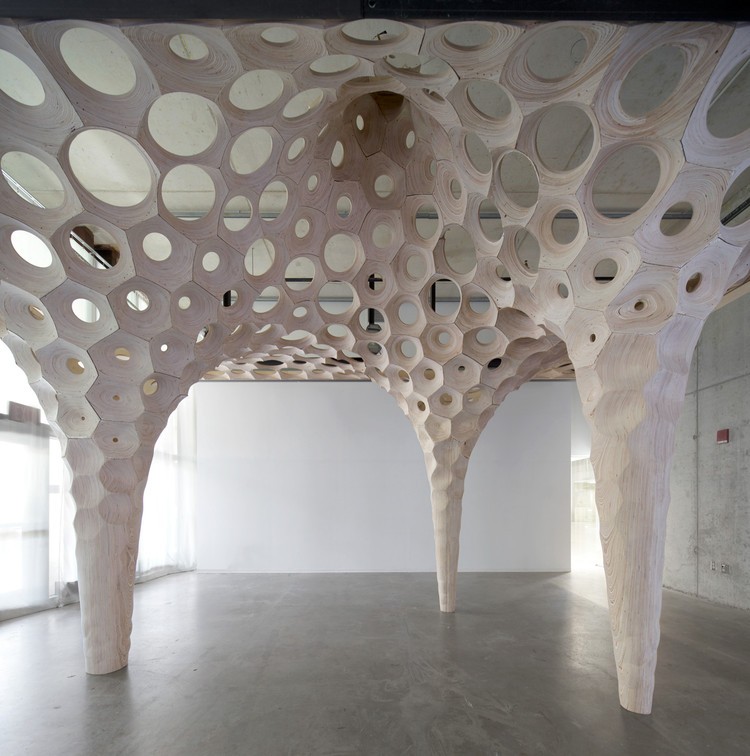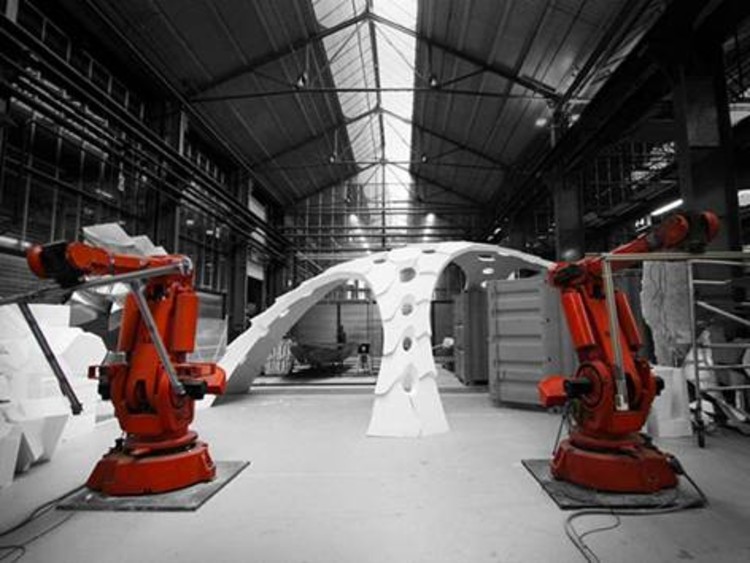A team of engineers at Autodesk have been pushing the limitations of conventional 3D printing -- not by redesigning the machines themselves, but by creating a network to harness their collective power. Autodesk's "Project Escher" is a new printing system that utilizes the power of several 3D printers at once to fabricate complex parts in unison, reports FastCoDesign. The new system can increase production speed by up to 90%.
robotics: The Latest Architecture and News
New Autodesk System Streamlines 3D Printing of Large, Complex Objects
5 Ways Architects Are Redefining Craftsmanship For a Postdigital Age

Craftsmanship is one of those topics which it seems almost everyone has a strong opinion. But while many lament the fact that traditional craft practices have been in decline since the industrial revolution, today a new generation of architects and designers have set about redefining and updating the notion of craft to include the most modern design and fabrication techniques around. In this article, originally published on Autodesk's Redshift publication as "5 Ways Architects and Postdigital Artisans Are Modernizing Craftsmanship," Jeff Link explores some of the traits that connect these pioneers to the craftsmen and women of a bygone era.
Craftsmanship in the digital age is hard to define. For some, craftsmanship evokes a purity of style, a preference for the handmade over the machine. For others, it recalls the Craftsman architecture of early-20th-century homes: overhung gabled rooflines, wide sheltered porches, detailed handiwork, and an ineffable Norman Rockwell sense of bygone Americana.
But regardless of one’s intuitive understanding of the term, the notion of craftmanship is evolving. Increasingly, the age-old knowledge of woodcarvers, masons, and other craftspeople is embedded in an intelligent design process using geometric computer models and machine fabrication to develop new crafts and architectural métiers—from gravity-defying furniture assemblies to complex workflows for robotic automatons. These innovations have helped place architects alongside craftsmen at the center of a revival in “maker” culture, which, for example, is in vivid display in handmade marketplaces such as Folksy and Etsy.
So what exactly is digital craft? And what does it look like in the work of top designers? Here, innovative architects identify five things postdigital artisans are doing to transform craftsmanship.
Achim Menges to Create Robotic Pavilion for V&A

Stuttgart experimental architect Achim Menges has been commissioned to kickstart the V&A's first ever Engineering Season with a site specific, nature-inspired installation fabricated by robots. Complemented by Ove Arup's first major retrospective, Engineering the World: Ove Arup and the Philosophy of Total Design, the Elytra Filament Pavilion will be Menges' first public commission in the UK. He will work with Moritz Dörstelmann, structural engineer Jan Knippers and climate engineer Thomas Auer to complete the project.
"Elytra Filament Pavilion will explore the impact of emerging robotic technologies on architectural design, engineering and making," says the V&A. "Inspired by a lightweight construction principle found in nature, the fibrous structures of the forewing shells of flying beetles known as elytra, the Pavilion will be an undulating canopy of tightly-woven carbon fibre cells created using a novel robotic production process."
New Construction Robot Lays Bricks 3 Times as Fast as Human Workers

A new construction worker has been lending high-efficiency help to job sites, laying bricks at almost three times the speed of a human worker. SAM (short for Semi-Automated Mason) is a robotic bricklayer that handles the repetitive tasks of basic brick laying, MIT Technology Review reports. While SAM handles picking up bricks, applying mortar and placing them at designated locations, its human partner handles worksite setup, laying bricks in specific areas (e.g. corners) and improving the aesthetic quality of the masonry.
Bone-Like Plastic Structures Form Biodegradeable Temporary Pavilions With "Osteobotics"

Architecture can be built with compressive elements and with tensile elements, but few materials have the ability to be stretched and also retain compressive strength. In a new project from Architectural Association DRL students Soulaf Aburas, Maria Velasquez, Giannis Nikas, and Mattia Santi, one of those materials, Polycaprolactone, a biodegradable polyester, is used to create framework from temporary pavilions and installations. Constructed using programmable robotic arms, the resulting product is a joint-less, self-supporting mono-material that shares a visual similarity to the structure of bones - giving the project its name, Osteobotics.
4 Experiments in Robot and Drone 3D Printing that Could Shape Architecture's Future

In manufacturing, the dramatic recent expansion in the capabilities of 3D printing has threatened to revolutionize the way that things are made. In architecture though, while 3D printing has been received with enthusiasm its translation to the increased scale of buildings has been challenging. Most solutions to this problem have focused on increasingly large printers and the incorporation of existing principles of prefabrication - however there is another way. In this article, originally published on Autodesk’s Redshift publication as "4 Ways a Robot or Drone 3D Printer Will Change Architecture and Construction," Zach Mortice looks at four examples of cutting-edge research into 3D printing that utilize robots or drones to navigate architecture's challenging scale.
Buildings simply aren’t made like anything else—that goes for sunglasses, furniture, appliances, and fighter jets. No other production process brings massive amounts of material to one place, constructs one item, and then hauls away the garbage. The inefficiencies are monumental.
Modular construction has promised a great deal of potential to reduce waste. But what if one answer is to do more intricate construction on-site, not less? 3D printers attached to robots and drones are demonstrating that they might have the versatility to finally bring the unruly building process to heel.
This 3D Printed Pavilion Provides Shade During the Day and Illuminates at Night

The Solar Bytes pavilion, designed by assistant professor at Kent State University Brian Peters, is a temporary structure which highlights the potential of new techniques available to architecture: robotic arms, 3D printing, smart technologies such as lighting sensors, and solar energy.
Leveraging the strength and range of motion of a robotic arm, the pavilion was printed in three dimensions with an experimental extruder, resulting in a structure composed of 94 unique modules that capture energy during the day, and shine at night. After their initial function, the plastic modules making up the pavilion will be completely crushed and reused in a new structure.
BIG and Heatherwick's Google HQ to be Built with Robots

Google's proposed California headquarters will be built with robots, according to the most recent planning documents received by the City of Mountain View Council. As the Architects' Journal reported first, the documents detail BIG and Heatherwick Studio's plan to construct the canopy-like structure's interiors with a team of robotic-crane hybrids known as "crabots."
These crabots would, in theory, establish a "'hackable' system for the building of the interior structures," says the documents, that would allow for limitless, easy, and affordable reconfiguration of space throughout the building's life.
Skanska and Foster + Partners Collaborate on World’s First 3D Concrete Printing Robot

Global construction company Skanska is teaming up with Foster + Partners and the engineers at Loughborough University (LU) to create the world’s first commercial 3D concrete printing robot. The company has signed an agreement with LU, who has been working on the project since 2007, to partake in an 18-month initiative with a consortium of partners focused on developing a robot capable of printing complex structural components with concrete.
A video about LU's research on 3D concrete printing and Foster + Partner's involvement, after the break.
MIT Develops Self-Assembling, Easy-Bake Robots
TERMES: A Robotic Swarm That Collectively Constructs Modular Structures
Termite mounds offer a fascinating architectural quandary: how is it possible that these towering structures (which include complex systems of openings, passages, large volumetric spaces, and even active ventilation systems and humidity regulation) are constructed with no centralised control or planning? The spatial complexity that these thousands of insects can collectively achieve has inspired a Harvard team to create TERMES, a project focused on programming an artificial robotic swarm to build modular structures.
Robots, Cars and Architecture

Since the dawn of the modern era, there has been a strong relationship between architecture and the car, especially in the works of Le Corbusier.
Le Corbusier was fascinated by his car (the Voisin C7 Lumineuse); the aesthetics of this functional, mass produced machine deeply influenced his designs. Its focus on function translated into his concept that houses should be "machines for living" and inspired a series of experiments of mass produced, pre-fab houses (such as the Maison Citrohan). Most of these concepts were later materialized in the iconic Villa Savoye, whose floorplan was even designed to accommodate the car's turning radius.
Architecture by Robots, For Humanity

Architecture is quickly adopting the popular technology of robots. Although it is slightly hard to define what “robot” really means, for architecture, it tends to refer to anything from robot arms to CNC mills to 3D printers. Basically, they are programmable, mechanical, and automated instruments that assist in processes of digital fabrication.
So, what might robots mean for architecture? A more precise architecture which could contribute to a more sustainable building life cycle? More innovative design derived from algorithmic processes? A more efficient prefabrication process that could reduce the time and cost of construction?
Probably a mix of all three. But more importantly, what might robots mean for humans? Robotic replacement for the construction worker? Loss of local craftsmanship and construction knowledge? Maybe. But I might reformulate the question. Asking what robots mean for humans implies passivity.
What I ask, then, is what can robots do for humans?
5 Robots Revolutionizing Architecture's Future

Robots fascinate us. Their ability to move and act autonomously is visually and intellectually seductive. We write about them, put them in movies, and watch them elevate menial tasks like turning a doorknob into an act of technological genius. For years, they have been employed by industrial manufacturers, but until recently, never quite considered seriously by architects. Sure, some architects might have let their imaginations wander, like Archigram did for their "Walking City", but not many thought to actually make architecture with robots. Now, in our age of digitalization, virtualization, and automation, the relationship between architects and robots seems to be blooming...check it out.
Keep reading to see five new robots making architecture.
Video: SCI-Arc Robot House
SCI-Arc‘s introduction of the Robot House (spring 2011) – a multifunctional robotics lab that enables the exploration of advanced fabrication techniques, manipulation of high tech materials, and numerous methods for simulation – has brought about a new and intriguing component to the school. Designed by faculty members Peter Testa and Devyn Weiser, its primary goal is the advancement of next generation platforms for the experimentation and future speculation of architecture.

















